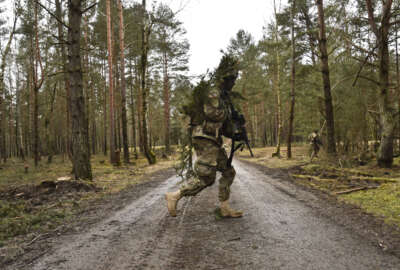
Generals: Army’s current drawdown plan creates ‘high risk’ in future conflicts
Generals say current analyses show the U.S. will need more land forces for future conflicts, precisely at the time the Army is shrinking to its smallest size since...
Several top generals told the Senate this week that the Army’s current, budget-driven plan to reduce its active duty force to its smallest size since before World War II creates a “high military risk” that it would not be able to defend U.S. interests against a capable competing military.
Current budgets have the Army on a gradual path to shrink to an active force of 450,000 by the end of 2017, down from a wartime peak of 566,000 in 2010. Much of the manpower decline has already happened: there were 482,000 soldiers on active duty last month, about the same number as in 2001, when the Army was not engaged in any major wartime operations.
“Our Army, in the future, risks being too small to secure the nation,” said Lt. Gen. H.R. McMaster, the deputy commander for futures at Army Training and Doctrine Command.
McMaster said a trend in which a small number of forces could have a large impact on big pieces of territory is now reversing itself, partially because potential competitors are much better at working in the cyber-electromagnetic domain and in the aerospace domain, making it more difficult for the U.S. to rely on air and sea power to meet its military objectives.
“I think the risk to national security will become unacceptable in terms of the size of the force. We see the demand for land forces going up just to do all of the things you’ve always wanted an Army to do, which is to defeat enemy organizations and consolidate those military gains as an inherent part of conflict,” he said. “When we try to solve complex, land-based problems exclusively from standoff range, you get a situation like the one we’ve seen in Libya, where we couldn’t consolidate those gains.”
Lt. Gen. John Murray, the Army’s deputy chief of staff for resources (G-8), declined to characterize the risks of the drawdown as “unacceptable,” but agreed the risks were “high” that a force of 450,000 would have serious difficulty with missions other than the counterinsurgency ones it’s currently engaged in. Gen. Mark Milley, the Army chief of staff, has made similar comments recently.
“Gen. Milley has said that we’d face high risk, but that does not apply to enemies like ISIL or the Taliban, it’s about the near-peer, state-type actors, and I absolutely agree with that,” Murray said. “But whether that risk is unacceptable or not is not our position to say. We’re happy to identify the risks, and then it’s up to our civilian leadership to determine whether that’s acceptable or not.”
Even at its current size, Army officials said there is almost no wiggle room within the current force to respond to a sudden crisis, should one occur. Put in terms of brigade combat teams, every BCT has already been spoken for in order to meet the Army’s existing commitments in Afghanistan, Korea, Europe and for homeland defense, said Lt. Gen. Joseph Anderson, the deputy chief of staff for operations and plans.
“Those add up to a total requirement for 56 brigade combat teams, and that’s exactly what’s in the inventory, both in the active component and in the National Guard,” he said. “Every brigade we have is committed under the Defense planning guidance, which tells us to deny and defeat adversaries and defend the homeland. That’s the math.”
The Army’s 2017 budget deliberately underfunded its facilities and its acquisition programs, the rationale being that training and other military readiness functions were much more important priorities given the service’s limited top-line budget.
As to acquisition, the Army’s current strategy is biased toward incrementally upgrading its existing systems and divesting the ones it’s decided it can live without. Most of the new acquisitions the Army had planned were reduced in quantity in the 2017 budget, a strategy that cuts one-year procurement costs but makes a system more expensive because it’s being purchased in smaller quantities.
But the Army has used the same strategy for several years in a row. Its research and development budget is now 54 percent smaller than in 2008 and procurement funding has fallen by 74 percent since that year. The military construction budget is at its lowest level in decades, even though 52,000 buildings on the Army’s bases are in poor or failing condition.
“If you asked me whether I’m concerned about risk in this particular budget, I would tell you no,” Murray said. “I’m more concerned about the cumulative risk, because this is exactly how we’ve been building our budgets for the last five or six years.”
Army officials said training and readiness for troops who are next to deploy overseas would have to remain their top funding priority, but cautioned congressional leaders that they could not simply order the Army to cease its drawdown without providing commensurate funding.
“If you increase the number of soldiers without an increase in the topline, it makes the problem we have right now even worse,” Murray said. “We’re always going to ensure the readiness of our soldiers, so that would mean modernization will take another hit. We can’t stretch things out much more than we already have, so we would have to go in and start canceling programs and slowing down production across probably every portfolio to the minimum sustainment rate. That means we would further decrement installations, MILCON and modernization to make sure that higher force level was trained and ready.”
Copyright © 2025 Federal News Network. All rights reserved. This website is not intended for users located within the European Economic Area.
Jared Serbu is deputy editor of Federal News Network and reports on the Defense Department’s contracting, legislative, workforce and IT issues.
Follow @jserbuWFED






